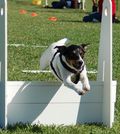 This is Cady, the dog we have now. She’s a mutt who needed a home. We adopted her as a near-adult stray. With the exception of being a cat-killing fool, and snapping at intruders when we’re not home, she’s been a pretty good dog. She’s eleven now and hasn’t really had any major health issues. She doesn’t even seem to be slowing down much. We got pretty lucky, as far as her health and disposition go.
This is Cady, the dog we have now. She’s a mutt who needed a home. We adopted her as a near-adult stray. With the exception of being a cat-killing fool, and snapping at intruders when we’re not home, she’s been a pretty good dog. She’s eleven now and hasn’t really had any major health issues. She doesn’t even seem to be slowing down much. We got pretty lucky, as far as her health and disposition go.
 That’s a far cry from the way we selected our first two dogs. They were high-class, pure-bred dogs. I spent a lot of time in the process of finding “the right dog” because I (at the time) felt like the veterinarian’s own dog should be a shining example of the super-dog. That’s not a bad idea, but these days I have other priorities than creating the super-dog. This is Anna, at six months.
That’s a far cry from the way we selected our first two dogs. They were high-class, pure-bred dogs. I spent a lot of time in the process of finding “the right dog” because I (at the time) felt like the veterinarian’s own dog should be a shining example of the super-dog. That’s not a bad idea, but these days I have other priorities than creating the super-dog. This is Anna, at six months.
Why get a pure-bred dog in the first place? Why not just take pot-luck with a mixed-breed puppy who needs a home?
Of course, we have “flavor of the month” syndrome, as when “101 Dalmatians” came out. Great Dane lovers fear that the Marmaduke movie will have a similar effect. Both of these breeds can be great dogs, but they can also be challenging to raise and care for. Neither are great choices for beginners.
 If you’re just looking at dog pictures without researching the characteristics of the breed, you’re liable to wind up with a dog like a Jack Russell Terrier. They are neat-looking dogs with a lot of personality. Best in the world for killing rats, grabbing things and shaking them to death, and repeat that process many times daily – a very busy dog. If nobody’s home all day, that dog is going to destroy your home. As the man said in “Indiana Jones and the Last Crusade”, you “…chose poorly.”
If you’re just looking at dog pictures without researching the characteristics of the breed, you’re liable to wind up with a dog like a Jack Russell Terrier. They are neat-looking dogs with a lot of personality. Best in the world for killing rats, grabbing things and shaking them to death, and repeat that process many times daily – a very busy dog. If nobody’s home all day, that dog is going to destroy your home. As the man said in “Indiana Jones and the Last Crusade”, you “…chose poorly.”
The most logical reason for purchasing a pure-bred dog is that you want particular characteristics of size, behavior, personality and appearance. You’ve researched a lot of different breeds and found one where the breed standard encompasses what you’re looking for. If you buy a puppy of that breed, you should have the dog you want when it grows up. With a mixed-breed, you don’t have nearly as much predictive ability of what you’ll wind up with.
Unfortunately, a lot of dogs are produced by commercial breeders who really don’t care if the dog grows up to be what you want it to be. He looks like the picture, but the biggest criterion for selecting the breeding stock was fertility. No attention has been given to trainability or personality. These are the puppies sold to brokers, and then to pet stores.
When you make that impulse purchase at the pet store, you are paying a pretty big mark-up for that convenience. The pet-store has to pay their people, their rent, and the broker, and make a profit. If you bought this same commercially bred dog directly from the breeder, you’d pay about one fourth the pet-store price.
So what should you do to buy the super-dog? First you identify the breed that will best suit your life-style so that you don’t set the relationship up to fail. Unfortunately, most breed books are written by enthusiastic proponents of the breed, and it’s not unusual to find that every breed you look at is good with children, a great watchdog, loyal, loves to play, and either came across the Alps with the Romans, or started out as a Tibetan temple guard.
There was a terrific book (now out of print) called “The Perfect Puppy” by Benjamin Hart and Lynnette Hart. It profiles fifty-six of the most popular breeds by thirteen key behavioral traits, like “ease of house-training”, “snapping at children”, and “dominance over owner”. My copy is falling apart, but I wouldn’t part with it.
Anyway, do some studying on the breed before you embark on your quest to purchase the perfect high-class pure-bred dog for yourself.
Once you’ve selected the breed, you want to find the breeder of your dreams. In my case, this would be someone for whom raising a couple of litters a year is their main hobby. They have several dogs and are committed to improving the breed by carefully selecting and planning the matings. Their dogs are carefully screened for heritable medical problems like hip dysplasia and eye problems. They sell the show-quality puppies for big bucks, and they are very careful about where their puppies end up.
Sometimes they produce a puppy that doesn’t quite measure up to their show-quality standards. They refer to these little guys as “pet quality”. They don’t think that they can win big at the shows, and they don’t want this puppy carrying their kennel name into an inferior breeding program. Often they will sell this pet quality puppy for about half what the show-quality pups go for. You have to agree to have the puppy neutered or spayed before they will give you the registration papers.
The thing is, the “pet quality” puppy from these folks is about ten times the dog you’d get from the pet-store (from the broker from the commercial breeder). He will be way better looking. He comes from parents certified (as best we can) to be free of the medical problems inherent in the breed. And the “pet quality” price is usually no more than the pet-store price for a dog from considerably less distinguished ancestry.
I’m not saying you can’t get a nice pet at a pet-store. I am saying that you pay a premium price for convenience instead of for a premium puppy.
So how do you find the breeder of your dreams? Now that you know who you are looking for, where do you find them?
This has got to be so much easier in the age of the Internet than when I first did it. Then, I had to go to the newsstand and buy Dog World and Dog Fancy. I looked through the classified display ads for the breed I was interested in. Then I contacted some of the folks to find out where to get more information on the breed. They told me about their breed association. You can probably do this in five minutes on your computer now.
I joined the breed association club, and subscribed to their newsletter. This let me find out more about the breed and its pros and cons. I also could see bloodlines, and get a feel for what a great Rottweiler (or Golden Retriever, in round two) looked like. After a few bi-monthly issues, I began to feel that I had a better idea of what I was looking for. You sort of get immersed in the enthusiasms and concerns of people who really care about their breed.
Next step, look at the membership list in the club and find breeders who are within driving distance. Call them up and tell them that you are not interested in breeding or showing, but you want to have a good, medically sound dog, and you think that a “pet-quality” dog from a committed breeder is what you are looking for. You want to learn more about the breed and would really like to visit them and see their dogs. Then you go do that, and you develop a relationship with the breeder you like best, and you get on a waiting list for a puppy.
 It is a slow process, but it worked great for me twice. This is Buster, in our Cowboy Christmas card back in 1991, when he was about six months old.
It is a slow process, but it worked great for me twice. This is Buster, in our Cowboy Christmas card back in 1991, when he was about six months old.


How did your “super dogs” work out?
FYI-you can find that book on ABEbooks.com and probably on Half.com or other sites that deal in out-of-print books.
I bought Spot from a breeder, but next time I’m going to get a mutt from the SPCA.
Generally I don’t read post on blogs, however I wish to say that this write-up very compelled me to try and do it! Your writing style has been surprised me. Thank you, quite nice article.
After sudden onset of hopping and inability to walk, boyfriend brought my dog in to be checked out. He has always been very active, running, etc. Radiographs were done which showed severe hip dyslplasia. He is about 6-7 year old Corgie-Chow or something mix. Vet said he is in severe pain (tough dog who doesn’t show pain) and will need to be on Rimadyl for the rest of his life without FHO Femoral Head Osteoectomy. I am willing to do surgery. I am in another state, and have only had brief phone conversation with vet. I will be in further contact with the vet on his condition and to ask questions; but just wanted your 2 cents on what the complications of the FHO (Femoral Head Osteoectomy) surgery are and the success rate. Both hips are bad and vet said sometimes when they do surgery on one, it “fixes” the problem and the second hip surgery is not needed. Do you know the stats on that: what percentage of dogs with two bad hips do well with one surgery? Depending on when we have the surgery done, how safe is Rimadyl long term?
Thanks for your valuable online prescene!
Hello, Jody Lynn,
The best way I know to assess the dog’s pain is to put him on Rimadyl, plus or minus something like Tramadol, for five days and see how much his activity and attitude improves.
FHO is removal of the femoral head (the “ball” of the ball-and-socket hip joint).
With dogs who have severe degenerative joint disease, the bony joint surfaces become very irregular and grind against one another. This is quite painful.
The FHO removes this bone-on-bone contact, relieving that source of pain. The dog then carries his weight via the muscular attachments to the rest of the thigh-bone. Now instead of a bony joint, his weight is supported by a sort of “muscle-sling”.
These dogs obviously will not be athletes, nor walk and run in a totally normal fashion. However, they are usually free of pain and have a much improved quality of life.
I am not an orthopedic specialist and cannot speak to the percentage of dogs that improve when they have two bad hips and surgery on only one.
Most dogs can take Rimadyl long term without difficulty. Checking liver enzymes and kidney function every six months is a good way to check to see if there are any hidden problems from taking the medication.
More obvious sings of difficulty with the medicine would be gastro-intestinal signs, such as loose stools, vomiting or blood in the stool. Most dogs do not have these problems.
Had the FHO surgery. We are 21 days Post Surgery. His hip is recovering well and he is walking on all four legs. But, whether from the trauma of the surgery or from limping around on 3 legs for short while, he is having sciatic pain. I did read that sciatica is a rare complication of the surgery. Had check-up today and vet thinks he is ahead of many dogs as far as the walking and healing of the surgery side. He goes from walking on all four legs to hopping when the pain comes on and jerking his head to his back/tail. He has okay nights and bad nights. The painful restless nights of licking non surgery side and /or licking sheets incessantly are driving my boyfriend crazy. Went back last week and vet gave him a cortisone injection (the dog). Now vet wants us to call in for appt as needed. The next step will be predisone. I think he wants to wait for a wash-out period of medications (he’s on rimadyl and tramadol), valium when things are really bad. I am in NM, boyfriend is diligently rehabbing the dog in AZ. We don’t get much time with the surgeon and the regular vet has not met with us since insisting he needed surgery; ultimately my decision. I am feeling AWFUL for my putting my dog (and boyfriend) through this and feel like I should have taken a wait and see more conservative approach. Is sciatica in this situation usually temporary or chronic?
Hello, Jody,
Sorry to be late replying, I didn’t see this when I should have.
I suspect that this situation will be temporary and that in the long run you will feel that you have made the right decision.
I am sorry that you are not feeling you have adequate communication with your doctors that are actually seeing your dog.
I would recommend that you tell them you still have questions. Ask if you can email them.
Update:
The sciatic pain has subsided, and the incessant licking; he is finally sleeping through the night. Vet did not prescribe predisone afterall. I suspect there will be ups and downs along the way, but he is 5 weeks post surgery tomorrow and vet is pleased that he is walking better than most dogs at this stage. He will continue on Rimadyl for the other dysplastic hip. The vet saved the femoral head and it is a bit shiny where there was bone on bone grinding. No mention of checking liver
and kidney enzymes, but I will call and ask. Time will tell (or maybe not) weather I would do this again the same way. For now I am happy that his sciatic pain has subsided and he is starting to play again.
Thanks for your help.
Another upate:
Just over 4 months since FHO surgery and he is doing well.
He is up to 1.5 mile hikes.
Thanks for the good news!